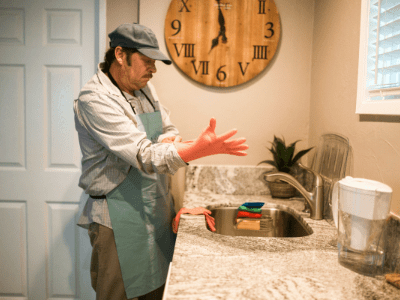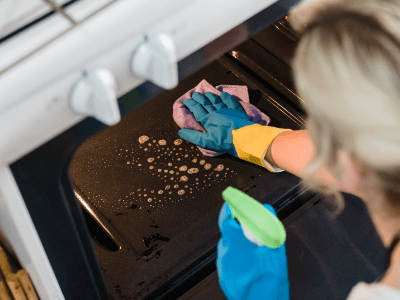
From removing stubborn grease stains to eliminating unpleasant odours, we've got you covered with a practical and easy-to-follow kitchen cleaning checklist that will leave your kitchen looking and smelling fresh. So, grab a sponge and let's get cleaning!
Make sure you have the right cleaning tools on hand, including a good-quality sponge, microfiber cloth, and non-abrasive cleaner. Choose products designed for kitchen use to avoid damaging surfaces or leaving nasty residues.
For general cleaning, a multi-surface cleaner or a solution of water and vinegar can work well. For tougher stains or grease, use a heavy-duty degreaser or a cleaner specifically designed for kitchen surfaces. Be sure to read the labels and follow instructions carefully to avoid damaging surfaces or causing harm to yourself.
It’s also worth getting everything together before you start cleaning – there’s nothing worse than having to take rubber gloves on and off!
Before you clean, it’s worth getting rid of anything you don’t need so it won’t be in your way. Start by getting rid of any expired food, old spices, and other items that are past their prime.
Next, consider removing rarely-used kitchen gadgets, duplicate utensils, and appliances that take up valuable counter space. Remember, the less you have, the easier it will be to keep your kitchen clean!
Are you cleaning the kitchen of your brand new home? Check out our new house checklist
Start scrubbing from the top of your kitchen and work your way down. This means starting with the highest surfaces, such as the tops of cabinets and shelves, then moving down to counters, appliances, and floors. Use a scrub brush or sponge to scrub away any stains or dirt, and make sure to rinse with clean water afterwards.
Beginners might benefit from this classic kitchen cleaning tip: for tougher stains or built-up grime, you may need to let the cleaning solution sit for a few minutes before scrubbing. Remember to pay attention to often-overlooked areas like the grout between tiles or the edges of appliances!
For regular cleaning, a solution of water and vinegar is a great natural option. Spray or pour the solution onto the sink's surface and let it sit for a few minutes before scrubbing with a sponge or brush. For tougher stains, use a heavy-duty cleaner specifically designed for sinks.
When scrubbing the sink, pay extra attention to areas around the drain and any crevices or corners where dirt and bacteria can build up. Rinse the sink thoroughly with clean water and wipe it dry with a clean cloth or paper towel.
If the drain is in need cleaning, pour one cup of baking soda and one cup of vinegar into it. Leave that mixture to sit – it will probably froth up into the sink, so ensure no dirty dishes are in it! After five minutes, pour two or more cups of boiling water down the drain.
Double-check that it is cool before cleaning your hob! Remove any grates, burners or knobs and soak them in warm soapy water. This will help to loosen any food or grease that may have built up.
Next, apply a non-abrasive cleaner designed for hobs and let it sit for a few minutes. Using a soft sponge or scrub brush, gently scrub away any stains or residue. Be sure to pay extra attention to areas where food or grease may have built up. You may have to repeat this step if the grime has had a chance to build up.
Once you've finished scrubbing, rinse the hob thoroughly with clean water and dry it using a clean cloth or paper towel. Do the same to the grates, burners or knobs you removed earlier. Cleaning a hob is often one the least popular jobs on the kitchen cleaning checklist, but it doesn't take long – and most of that time is spent soaking and leaving the cleaner to sit!
Maximise your Friday storage space and freshness with our tips on how to store vegetables!
As mentioned above, before you attempt to clean an oven, make sure it is entirely cool! Start by removing large pieces of debris from the oven using a scraper or spatula. Next, mix a paste using baking soda and water, and apply it to the oven's interior, making sure to avoid the heating elements. The baking soda will help to break down any grease or grime that may have built up.
Let the baking soda paste sit for several hours or, ideally, overnight. Then, using a damp sponge or cloth, wipe away the paste, and remove all residue. If there are still stubborn stains, you may need to use a commercial oven cleaner, following the instructions on the label carefully. Finally, rinse the oven thoroughly and dry it with a clean cloth or paper towel.

Fill a microwave-safe bowl with water and add a few slices of lemon or a tablespoon of vinegar. Place the bowl in the microwave and run it for 2-3 minutes until the water starts to boil. This will create steam that will help to loosen any food or grease that may have built up.
Once the microwave has cooled down, remove the bowl and use a damp sponge or cloth to wipe away any residue. Pay special attention to the areas around the door and the turntable. You may need to use a mild cleaning solution or a specialised microwave cleaner if there are any stubborn stains. Most microwaves include removable turntables, so you can remove them and thoroughly scrub them in the sink.
Finally, rinse the interior of the microwave with clean water and dry it using a clean cloth or paper towel. Make sure to also clean the exterior of the microwave with a damp cloth or sponge – a shiny microwave will be a friendly reminder of the thorough cleaning you’ve achieved!
If you have a dishwasher, cleaning it is next on our kitchen cleaning checklist. Using a damp sponge or cloth, wipe down the dishwasher's interior, including the racks and the walls. Gently scrub it to remove any residues.
Next, run a cycle with an empty dishwasher and a specialised dishwasher cleaner according to the instructions on the pack. Calcium may have built up if you live in an area with hard water. In that case, try running a cycle with an empty dishwasher with a cup of vinegar on the top rack.
Is cooking your passion? Check out our top kitchen gadgets!
If you’ve done everything so far, congratulations! The bad news is that it’s just a matter of time before you’ve got to do it all again. You might find it helpful to set up a regular cleaning schedule for your kitchen, including daily, weekly, and monthly tasks. This will help you stay on top of cleaning and prevent dirt and grime from building up.
That’s it for our kitchen cleaning checklist. If you’re decluttering your kitchen, moving house, or need storage for just about anything else, we can help!
Our cheap, modern storage facilities are located all over the country. Find your nearest facility and get a free quote today using our online store finder.